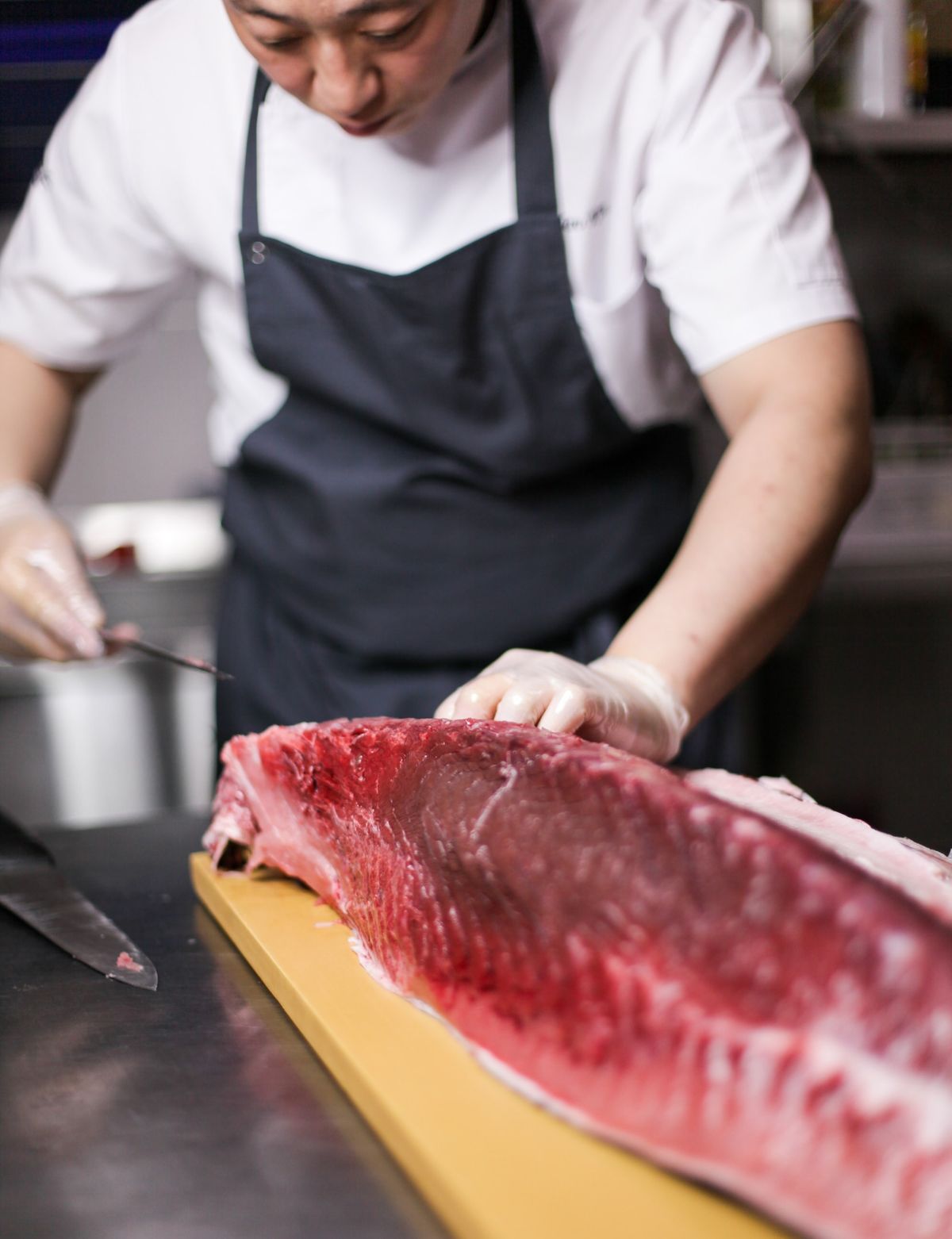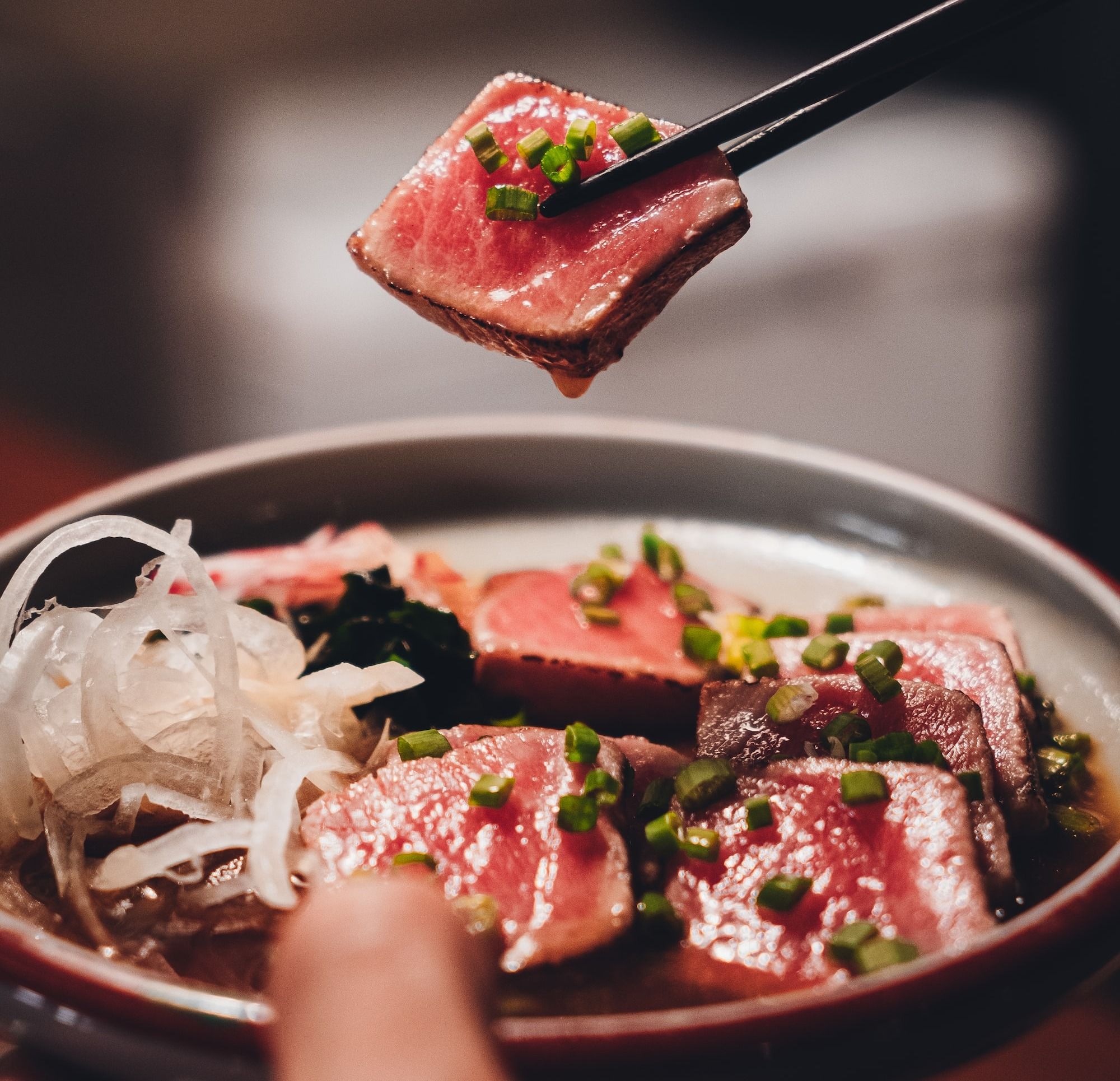What Are The Most Expensive Cuts of Bluefin Tuna?
The 3 Best Cuts of Bluefin Tuna Explained

The grading of tuna sushi is determined by its fat content, mirroring the way beef is graded by observing the marbling within the cut.
In Japan, Bluefin Tuna, scientifically termed as Thunnus thynnus and known as 'Thon Rouge' in French, is commonly referred to as 'Maguro'.
The Maguro is a magnificent creature, capable of growing up to 15 feet and tipping the scales at a massive 2,000 pounds. These powerful swimmers are among the ocean's speediest and most robust fish. Despite stringent fishing regulations, the global demand for high-quality bluefin tuna continues, especially among renowned restaurants and markets.
Knowing Your Tuna Varieties
There are five primary tuna varieties: honmaguro (northern bluefin), minamimaguro (southern bluefin), mebachimaguro (bigeye), kihadamaguro (yellowfin), and binnagamaguro (albacore).
Their prices can differ based on multiple factors, including their type, origin (wild-caught or farm-bred), and whether they've been frozen.
Wild-caught northern bluefin, especially from the ocean, often commands the highest prices.
Their market value is more volatile as their catch numbers are significantly impacted by environmental conditions, unlike the more controlled environment of fish farms.
The origin of the tuna catch further affects its price. For instance, a 100-gram slice of the renowned Oma brand northern bluefin, sourced from the ocean, might be priced around 2500 yen ($18) per 100 gram.
In contrast, an equivalent portion from a tuna caught abroad might be available for around 1900 yen ($14) per 100 gram.
Choosing Bluefin tuna sourced from sustainable methods such as pole and line fishing is crucial, especially considering the species' decline. This way, you can enjoy culinary luxury while also supporting ocean health.
Bluefin Tuna Cuts Explained
Various segments of the bluefin are utilized for a variety of dishes. Some segments boast a richer flavor, higher fat content, or meatier texture.
Among these, Chutoro and Otoro stand out as prime cuts, revered for their rich fat composition and an irresistibly smooth texture. So let's delve deeper into the world of Toro, Chutoro, Otoro and Akami a mouth-watering section of the tuna.

Toro (Fatty Part)
Toro refers to the rich, fatty segment found in the belly of maguro tuna, notably the most luscious part of the fish's abdomen. Its supple texture allows it to effortlessly melt on the palate.
This section of the maguro fetches a premium price due to its scarcity and the limited quantity available.
Besides being decadently flavorful, toro is nutritionally packed, boasting high levels of DHA and EPA. Additionally, it is a good source of vitamins A, D, and E, though it's worth noting its high caloric content.
Beyond the traditional presentation as sushi or sashimi, toro is sometimes transformed into a paste, gracing the top of gunkan sushi as "negitoro" (ネギトロ).
This prized Toro comes in two distinct varieties: "Otoro" and "Chutoro". Let's delve deeper into the nuances of these two categories.
Otoro (Fattiest Portion)

Otoro is the prime cut of the maguro tuna, distinguished by its richness and located predominantly in the tuna's abdominal region. This cut, visually more white than red, owes its coloration to its high fat content.
But instead of a greasy taste one might expect, Otoro offers a melt-in-your-mouth experience, presenting a sweeter flavor compared to the leaner akami cut.
Historically, before the invention of refrigeration during the Edo period, this cut was often discarded as it spoiled more rapidly than the meatier sections.
However, with modern preservation techniques, Otoro's value has been recognized, making it one of the most sought-after and priciest cuts from the bluefin tuna.
Best savored in its sashimi or nigiri forms, Otoro is particularly delectable during the winter when the tuna fattens up.
When paired with shoyu with a hint of wasabi, its rich flavors are accentuated, offering a sublime dining experience.
Its exquisite quality makes it best consumed fresh, with the K value serving as a reliable measure of its freshness to ensure optimal taste and safety.
While Otoro is a celebrated seafood delicacy in Japan, authentic cuts remain rare to find elsewhere.
Chutoro (Mid Fatty Portion)
Chutoro, originating from the belly of maguro, is celebrated for its medium fatty content, striking a balance between the rich Otoro and leaner Akami.
The term "Chu" translates to “middle” in Japanese, aptly describing its intermediary fat content. Sourced from both the belly-to-back region and the lower rear of the tuna, Chutoro offers a harmonious blend of meaty texture with a tinge of sweetness, akin to Akami but richer.
This cut's vibrant deep pink hue, interspersed with marbling, speaks of its fat composition, placing it between Akami and Otoro.
Often served as sashimi, Chutoro stands out even without the accompaniment of sushi rice, its sublime flavors shining through. It's a premium part of the tuna, hence its costliness, but it's relatively more affordable than Otoro.
While the traditional presentation is sashimi, variations exist. Occasionally, it's seared briefly on both sides, altering its texture but possibly overshadowing its innate taste.
Chutoro is also sometimes integrated into sushi rolls (maki), wrapped with assorted veggies in nori. Though not the most traditional method, it caters to diverse palate preferences.
When dining out, if tuna specifics aren't provided on the menu, it might indicate a grade below the esteemed Chutoro or Otoro.
Akami (Leaner Meat)
Akami is the standard tuna offering at many Japanese dining establishments. When a menu lists "maguro" under sushi or sashimi, it's typically referring to this part of the tuna.
This deep-red, lean cut, whose name "akami" translates to "red part" in Japanese, stands apart with its minimal fat. Given its prevalence within the tuna, it's both a frequent find in grocery aisles and the most economical choice among tuna cuts.
Ordering "maguro" at sushi joints will usually land you a slice of Akami, known for its unmistakable umami flavor, distinct from the richer profiles of its counterparts, chūtoro and otoro.
Why is Toro so Expensive?
Toro's high price tag stems primarily from its rarity. This term refers to the fatty section of the tuna belly. Within this classification, the extremely fatty part is known as Otoro, while the moderately fatty section is termed Chutoro. Akami, a cut that is frequently found in supermarkets, is lean with minimal fat. The tuna's market value is largely determined by its fat content.
Essentially, Toro represents just a segment of the already valued and pricy tuna. To put it into perspective, Otoro makes up only about a fifth of the entire Toro portion, meaning the quantity of this prized fat obtained from each fish is minuscule. Its allure isn't just its scarcity; its impeccable flavor, melt-in-the-mouth texture, and superior nutritional profile set it apart.
For instance, it's believed to contain over double the amount of certain nutrients like vitamins A and D compared to an equivalent quantity of red meat. Plus, its richness in DHA makes it a tasty and health-beneficial delicacy. Despite its premium price, its demand remains consistently high, testament to its unparalleled qualities.
What is Otoro Tuna?
Otoro tuna represents the crème de la crème of the Toro, which is the tuna's underbelly. Positioned closest to the fish’s head, Otoro boasts the highest fat content, lending it a delectably rich flavor. Its scarcity makes it a rare delight and explains its premium price tag. But for aficionados, the cost mirrors the unparalleled taste experience this cut offers.
What Type Of Tuna is Otoro?
Originating from the Northern Bluefin tuna, Otoro is especially coveted. Considering that the Bluefin tuna itself is among the priciest tuna varieties, Otoro elevates this prestige even further, being the most luxurious segment of this already esteemed fish.
What is the Difference between Otoro and Chutoro?
When you talk about Toro, you're referring to the broader fatty underbelly of the tuna. But within this, there are nuances. Toro can be further distinguished into Otoro and Chutoro. While Toro itself possesses a notable fat content, Otoro and Chutoro elevate this characteristic, with Otoro being the fattiest, rendering a profound depth in flavor.
What Does Otoro Taste Like?
Imagine a slice of fish that almost dissolves on your palate. Otoro delivers this unique melt-in-your-mouth sensation, combined with a profound umami depth. Intensified flavors, with traces of sweetness, set Otoro apart. Many compare the experience to savoring the marbled fat of a high-grade prime rib, but imagine it in a fishy context, minus the overt beefiness.


